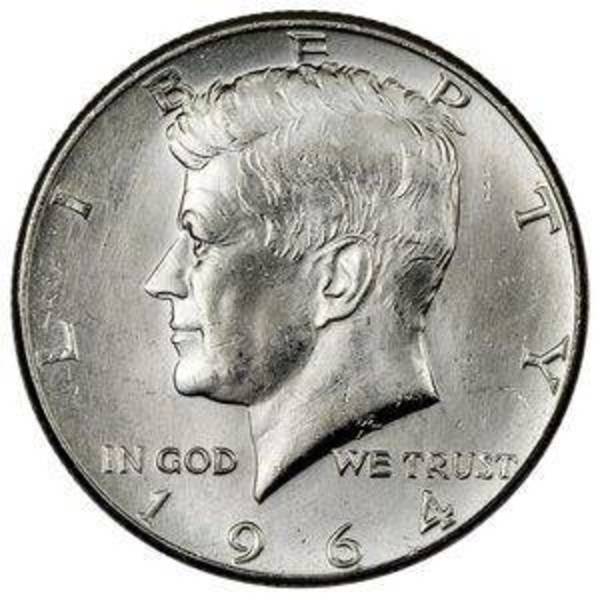Junk Silver Coins
90% silver coins were in everyday circulation prior to 1965
Learn More About Junk Silver Coins

Junk Silver is a term used for circulated silver coins having little numismatic or collectible interest. They are bought for the intrinsic value of the metal. Composed of 90% silver and 10% copper, these include dimes, quarters, and half dollars minted through 1964.
Today, 90% silver coins are a favorite among investors, preppers, and collectors due to their low premium, recognizability, and liquidity.
This is still recognized as U.S. coinage, though the intrinsic value is worth far more than the face value.
90% Silver Coins
Each $1 face value contains roughly .715 troy ounces or 22.23 grams of pure silver. Utilizing 90% silver coins as a store of wealth is one of the most practical investments one can make. It is affordable and can be stored in normal bankrolls or bags.
Roosevelt and Mercury dimes, Washington quarters, Franklin, Kennedy, and Walking Liberty half dollars are all common examples of coins found in bags of junk silver.
All Mercury dimes were minted with silver and Roosevelt dimes minted before 1965.
The Washington Quarter was introduced in 1932 and minted with 90% silver until 1964.
Franklin half-dollars were minted from 1948 until 1963 and then was replaced by the Kennedy silver half-dollar in 1964.
In standard face-value denominations, mixed junk silver is often the cheapest option for investors looking to add weight to their holdings. The intrinsic silver value is the primary appeal.
Making bulk purchases of circulated silver coins is the most effective way to pay the cheapest price and get a low premium. Junk silver is widely recognized and simple to authenticate without special tools or chemicals.
40% Silver Coins
U.S. Mint 40% Silver Coins were produced during the debasement period in the late 1960s when the government transitioned from minting silver coins.
From 1965 to 1970, Kennedy half-dollar coins were minted with 40% silver before switching to base metals in 1971.
40% silver coins contain offer an affordable way for silver investors and collectors to own a piece of U.S. coinage history.
The Kennedy Half Dollars, Eisenhower Silver Dollars, and unique Bicentennial coins are notable examples from this era.
35% Silver Coins
Wartime Jefferson Nickels contain 35% silver and were minted from 1942 to 1945 during World War II when the U.S. government needed to preserve nickel for military purposes. Silver was a practical solution to maintain coinage while conserving strategic materials.
Each wartime nickel contains about 0.05626 troy ounces of pure silver. Despite their relatively low silver content, they are still collected and traded primarily for their silver bullion value.
These coins are notable for having an oversized mint mark on the reverse, above the dome of Monticello, indicating that they contain silver.
Identifying Junk Silver Coins
Junk silver coins have a different appearance than modern clad issues and can be identified with a simple visual examination, looking for specific characteristics that stand out.
The first and most obvious thing to look for is the date. The last year 90% silver coins were issued for circulation was 1964.
Along with the date, the reeded edge on pre-1965 coins is entirely silver. With modern clad coins, the copper core is visible through the coin edge.
Another way to identify silver coins is by their sound when dropped onto a solid surface, such as a countertop or a table. The "Ping Test" is easily recognizable for experienced stackers and preppers. Also, Apps are available for mobile phones that help investors distinguish between authentic 90% silver and clad.
Buying 90% Junk Silver
Junk Silver continues to be one of the cheapest and most affordable ways to begin buying silver as a store of value and wealth.
The majority of junk silver is comprised of silver half-dollar, quarter, and dime coins, which are easy to buy from online bullion dealers and marketplaces like eBay.
Additionally, various well-established "buy/sell" communities and groups exist on Facebook, Reddit, Instagram, and other social media and community forums.
Locally, you can usually find junk silver at pawn shops, We Buy Gold stores, local coin shops, and some antique stores.
In some areas, it's possible to find accessible opportunities to buy, sell, and trade using silver gold for products and services. Online bullion dealers typically sell junk silver in lots based on the total face value of all denominations.
Which Coins are Considered Junk Silver?
In the U.S., junk silver typically includes:
- Dimes (10 cents): Mercury dimes (1916-1945) and Roosevelt dimes (1946-1964) 0.07234 troy ounces of silver.
- Quarters (25 cents): Washington quarters (1932-1964) 0.18084 troy ounces of silver.
- Half dollars (50 cents): Walking Liberty half dollars (1916-1947), Franklin half dollars (1948-1963), Kennedy half dollars (1964) 0.36169 troy ounces of silver.
- Dollars ($1): Morgan dollars (1878-1921) and Peace dollars (1921-1935) may also be considered junk silver. Morgan and Peace dollars contain slightly more, with .7734 troy ounces.
Many investors consider junk silver a good investment due to its low premiums over the spot price of silver. It's also useful for fractional silver investments since dimes, quarters, and half dollars are more diminutive than silver bullion coins.
The value of 90% Junk silver is based on the current spot price. The value of a junk silver coin is determined by its weight in troy ounces of silver and the prevailing spot price, with a slight premium added by dealers.
Can I still find 90% Junk Silver in circulation?
While it is rare, 90% silver coins can still be found in circulation. Coins dated 1964 or earlier (specifically dimes, quarters, and half dollars) can sometimes be seen while coin roll hunting rolls of change from banks, but this is uncommon due to their value as silver bullion.
Where do I buy junk silver?
You can buy junk silver from:
- Online bullion dealers
- Local coin shops
- Coin shows and auctions
- Flea markets, some antique stores
- Private sellers or markets
It is typically sold in face-value increments, such as $1, $10, or $100 face-value bags of coins.
What is a "face value" bag of junk silver?
A face value bag refers to the total face value of the junk silver coins. For example:
- A $100 face-value bag of junk silver quarters would contain 400 quarters (each with a face value of $0.25).
- A $1,000 face value bag typically contains 715 troy ounces of silver, including $1,000 worth of dimes, quarters, or half dollars made before 1965.
Where to buy the cheapest Junk Silver Coins
We help find the best prices for the cheapest Junk Silver Coins when you're ready to buy.
FindBullionPrices.com compares precious metals prices from trusted and reputable online bullion dealers to help you find the lowest prices on Junk Silver Coins. The prices on our site are updated hourly and adjusted for spot silver price. This gives you the tools to compare silver prices.



















.jpg)


























